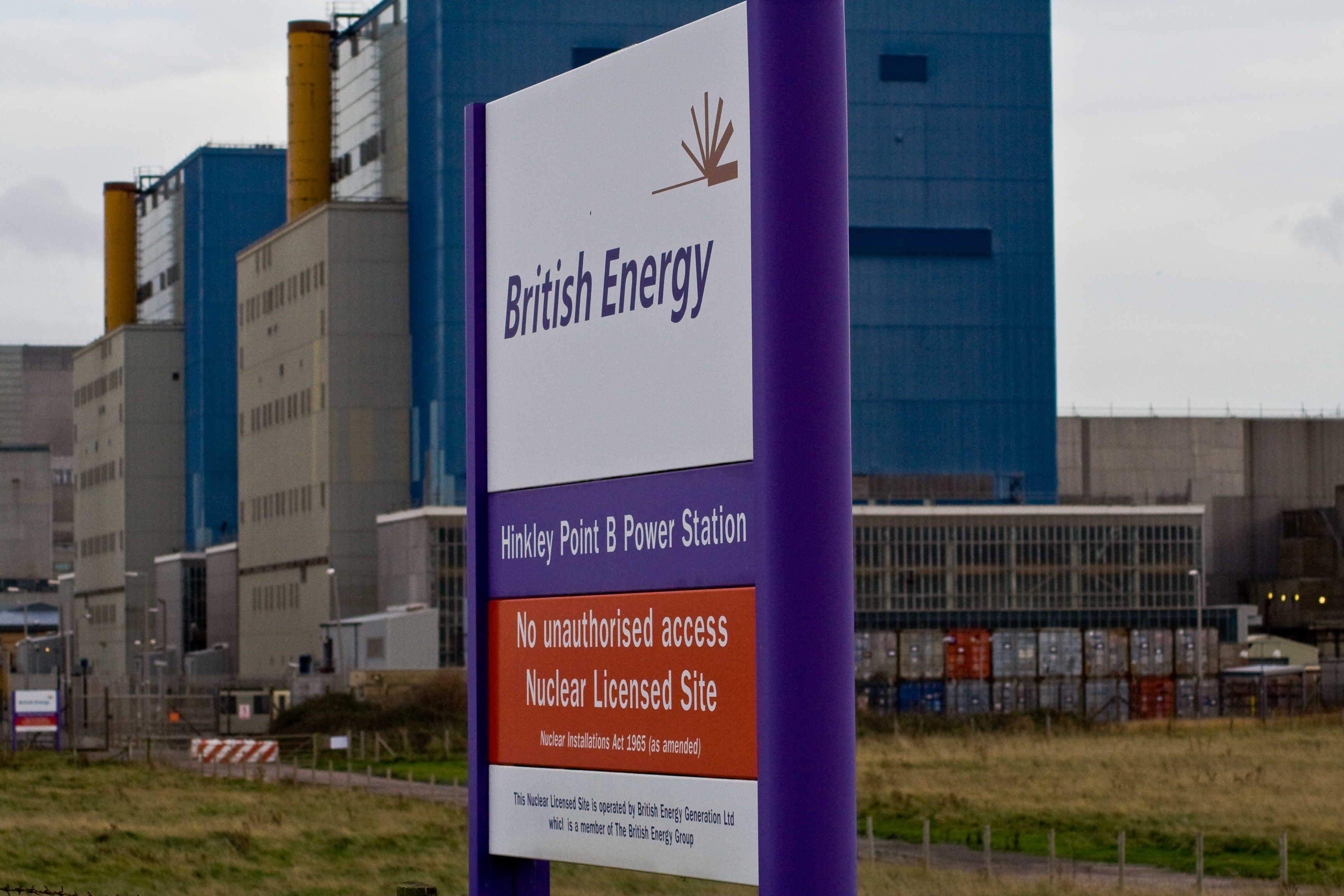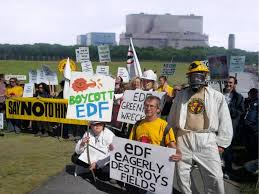
The headlines flash daily about major changes in energy policy in the UK; none of them good news. The slashing of support for solar, energy efficiency and other clean energy programs and at the same time an apparent intent to spend absolutely mind-blowing amounts of money on new, untried, and highly risky nuclear power reactors. From the point of view of an America where, haltingly but steadily, clean energy is gaining a true foothold and is moving ahead, it seems incomprehensible that our closest ally would move in the opposite direction of most of the world’s industrial economies. Could that really be true?
So we asked veteran UK activist Pete Roche to explain what is happening in the UK. And no, the news really is not good.
David Cameron’s Conservative Government has now been in power in the UK, without the constraining influence of the Liberal Democrats, for 100 days. From the point-of-view of the environment his new government has been an unmitigated disaster; marked by a sharp embrace of dirty energy sources in a fashion most advanced nations, even including the U.S., are stepping away from.
From the moment the new Government was elected it set about burning the green policies of the previous coalition government. Subsidies for new onshore wind farms, paid for through consumers’ bills, are to end from April next year as are subsidies for solar farms. There will be a review of the feed-in tariff threatening subsidies for solar panels on domestic and commercial roof tops. And other proposed changes will make it much harder for community renewable projects to obtain finance.
The Government has also killed off the Green Deal scheme which provided loans to households for energy efficiency improvements. The scheme was a damp squib but what’s striking is there are no proposals to replace it. And a decade-long plan to force all new homes to be ‘zero carbon’ from 2016 has been dumped. On top of all this the exemption for renewables from the Climate Change Levy–a kind of carbon tax–has been removed, effectively imposing cuts to the income of renewable projects already up and running retrospectively.
The new Secretary of State for Energy and Climate Change, Amber Rudd, told Members of Parliament (MPs) that carbon reduction targets are a bigger priority than meeting renewable energy targets, signalling that she is prepared to miss the UK’s European Union Renewable Target of meeting 15% of our energy needs (not just electricity) from renewable sources by 2020. Instead she will try to meet the UK’s carbon reduction commitments with nuclear power and fracked gas. She defends her cuts to renewable energy subsidies saying “we need to reduce our emissions in the most cost-effective way.” Cutting support for the very technologies–onshore wind and solar–that can deliver both lower bills and energy security in the long term seems to be a very odd way of going about it.
(Of course, this is the same Amber Rudd who said that if nuclear reactors were just prettier, everyone would like them. ed.)
The problem is that nobody knows yet what measures, if any, the Government plans to implement to replace the measures scrapped. So we have no idea how the Government intends to meet its legally binding obligations under the UK’s Climate Change Act. If it chooses to try meeting its carbon targets without onshore wind, for instance, it must explain why it is taking a more expensive route towards decarbonisation.
Andrea Leadsom, another Minister in the Department of Energy and Climate Change, told MPs that the Government hopes to be able to meet 35% of the UK’s electricity requirements from nuclear by 2028. Initially it is planning subsidies for two new EPR reactors at Hinkley Point C in the West of England which have been independently costed at an extraordinary £76 billion ($121 billion). To get to 35 percent, all 11 of the currently proposed reactors (about 15.2GW) would have to proceed without too many delays and then would have to operate at a rather unlikely 90% capacity factor (the amount the plant generates compared to the amount that would be generated if it was operating at full power all of the time).

Four of the proposed reactors, including the two at Hinkley, are EPRs and we know the only other EPRs being built are all late and probably over-budget. (No reliable cost information has been published for the two in China). Three AP1000 reactors are proposed for Moorside near Sellafield and experience of the United States suggests this reactor type is no better at being built on time and budget. Four Advanced Boiling Water Reactors (ABWR) are proposed–two for Wylfa on Anglesey and two for Oldbury in Gloucestershire. These are presented as the only reactors which have operational experience, but UK regulators nonetheless have raised a series of “shortfalls” in their design. None of the ABWRs already built, all of which are in Japan, have a capacity factor above 73% and two have capacity factors of less than 40%.
On top of the initial 15.2GW of nuclear reactors proposed the Government appears to be planning to hand over the a site at Bradwell in Essex, just north of London, to the Chinese National Nuclear Corporation. And the Government is supporting research into Small Modular Reactors (SMRs) with plans being drawn up for the world’s first SMR to be built on land next to the existing Hartlepool (AGR) nuclear power plant in County Durham with perhaps up to 7 GW of SMRs to follow by 2035.
Even that doesn’t complete the picture, because the Government-owned Nuclear Decommissioning Authority (NDA) appears to be focusing its efforts in dealing with the UK’s embarrassing plutonium stockpile on evaluating two different reactor projects–the GE Hitachi PRISM reactor and the Candu Energy Canmox project with the latter reported in June as the front-runner. Ontario-based Candu Energy is proposing to turn plutonium into mixed oxide (MOX) pellets at a dedicated fabrication facility at Sellafield. The MOX fuel could then be used in four thermal reactors to produce up to 3GWe of electricity.
This developing hard energy path for Britain has also seen an announcement this week by Rudd of plans to fast-track shale gas planning applications. The measures are designed to ensure the industry gets up and running without delay, after the industry in the UK has failed to take off in the face of public opposition and opposition from local municipalities. Rudd says we need shale gas to “help meet our objectives for secure energy supplies, economic growth and lower-carbon emissions.” But UK fracking is likely to need until the mid-2020s to scale up. Government projections are that coal will only generate 1% of our electricity by 2025, and we need to phase-out fossil fuel-based gas “quite rapidly” in the 2030s if we are going to meet our climate commitments. So if the Government is telling the truth about wanting to meet our climate change commitments, starting to frack now is pointless.
On the positive side, commentators from industry, politics and the financial sector have been lining up to condemn the Government’s plans to subsidize the first new reactors proposed at Hinkley. An investment decision is expected soon, possibly to coincide with a visit by Chinese President Xi Jinping in October, because China is expected to contribute two-thirds of the upfront capital for the project. Words like “white elephant” and “lunacy” are being bandied around even in the right wing press. The Chief Executive of the UK subsidiary of German Utility RWE has branded the project an “expensive mistake.” Even the father-in-law of the Chancellor of the Exchequer has called it “one of the worst deals ever for British households and British industry.” Analysts at HSBC Bank say there is “ample reason for the UK government to delay or cancel the project”.
We have to hope this growing chorus of critics calling for Hinkley Point to be scrapped will have an impact, because as many of us know on both sides of the Pond–in the words of UBS Bank “Large-scale power generation … will be the dinosaur of the future energy system: Too big, too inflexible, not even relevant for backup power in the long run.”
Pete Roche is editor of the www.no2nuclearpower.org.uk website and Press Officer for the Stop Hinkley Campaign – www.stophinkley.org
August 14, 2015
Permalink: https://www.nirs.org/what-is-happening-in-the-uk/
Your contributions make publication of GreenWorld possible. If you value GreenWorld, please make a tax-deductible donation here and ensure our continued publication. We gratefully appreciate every donation of any size.
Comments are welcome on all GreenWorld posts! Say your piece. Start a discussion. Don’t be shy; this blog is for you.
If you’d like to receive GreenWorld via e-mail, send your name and e-mail address to nirs@nirs.org and we’ll send you an invitation. Note that the invitation will come from a GreenWorld@wordpress.com address and not a nirs.org address, so watch for it. Or just put your e-mail address into the box in the right-hand column.
If you like GreenWorld, help us reach more people. Just use the icons below to “like” our posts and to share them on the various social networking sites you use. And if you don’t like GreenWorld, please let us know that too. Send an e-mail with your comments/complaints/compliments to nirs@nirs.org. Thank you!
GreenWorld is crossposted on tumblr at https://www.tumblr.com/blog/nirsnet




Reblogged this on nuclear-news.
Michael, I don’t know why you’re surprised. The UK (excluding Scotland) and it’s offspring, (Australia, Canada, the US and India) are, hosts to some of the most recalcitrant climate obstructionists on the globe.
I really don’t understand it myself, but I think it is safe to say that something in the Anglo economic/political heritage is about as dysfunctional as it gets.
I’m not surprised so much as very disappointed; the UK had been making some strong strides toward clean energy in recent years, now they are moving 180 degrees in the opposite direction.
The Hinkley C project is now mired down in lawsuits and that is a great thing for all the UK ratepayers that will have to “pay” for too high priced Nuclear Energy for decades to come, plus that is before they have to decommission it and try and store the ☢ Waste someplace.
http://www.theguardian.com/environment/2015/aug/09/planned-hinkley-point-nuclear-power-station-energy-industry#comment-57322727
Nuclear IS TOO Expensive for everyone except those that profit from Nuclear!
Here is another example from the US for the operating cost of a new reactor:
http://www.nucnet.org/all-the-news/2014/05/27/france-s-state-auditor-says-edf-s-nuclear-costs-are-increasing
That’s about $0.08/kWh for electricity from paid off reactors.
US onshore wind is now about 4 c/kWh unsubsidized. US PV solar is now about 6.5 c/kWh unsubsidized. That for new capacity and their costs will fall to about 1 c/kWh upon payoff. Compare both the new and paid off wind and solar prices to France’s 8 c/kWh for paid off nuclear.
If new Vogtel energy costs 18 c/kWh who is going to profit from using it?
Ratepayers will be held in Energy Slavery as long as Vogtel operates figure 20 to 40+ years as regulators force them to buy Energy instead of installing their own residential Solar.
The momentum to stop using Nuclear is growing Globally and if it were not for the Nuclear Utility “gangs” donating/controlling Governments we would be decommissioning all nuclear reactors. In the years since Fukushima you have continually supported the use of Nuclear but more reactors are being decommissioned than ever before, so the percentage of Energy generation from Nuclear is dropping Globally as both Wind and Solar Generation costs keep dropping almost monthly. Solar (of all flavors) along with battery technology will shift even more away from accepting Nuclear Energy and that is if nothing BAD occurs.
Even French nuclear scientists and engineers are concerned about Chinese reactors:
China Regulators … http://www.bloomberg.com/news/articles/2014-06-18/french-nuclear-regulator-says-china-cooperation-lacking
And elsewhere
Greenpeace nuclear expert: ‘There’s always something’ | Europe | DW.COM | 14.08 https://shar.es/1tDWha
+
http://ecowatch.com/2015/08/14/shut-down-diablo-canyon/
Here is one of the longer running discussions about UK nuclear and it is filled with additional comments:
https://www.cfact.org/2013/11/02/u-k-takes-down-infographic-showing-footprint-of-nuclear-vs-renewables/